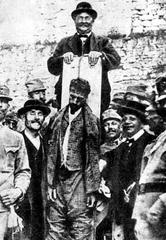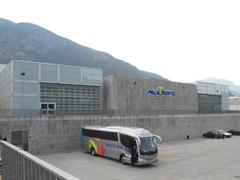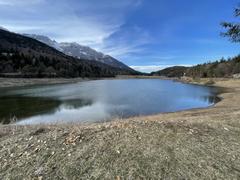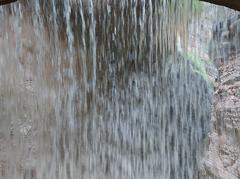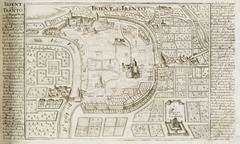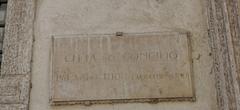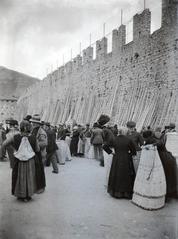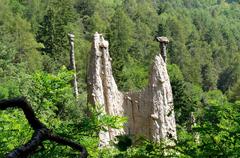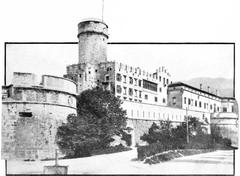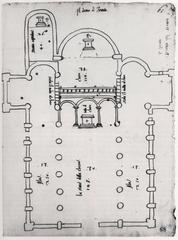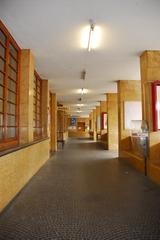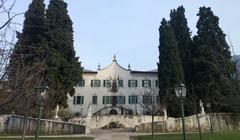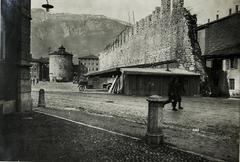Fortezza di Trento Visiting Hours, Tickets, and Historical Sites in Trento, Italy
Date: 04/07/2025
Introduction
Rising above the Adige Valley and overlooking the city of Trento, the Fortezza di Trento is a vast network of fortifications that bear witness to the region’s complex military and cultural history. Spanning the 19th and early 20th centuries, these interconnected forts, batteries, and defensive structures once safeguarded vital Alpine passes and communication routes between Italy and Central Europe. Today, the fortress offers visitors a rich blend of history, panoramic views, and vibrant cultural programming, making it a must-see for anyone visiting Trento.
This comprehensive guide covers the site’s historical importance, architectural features, practical visitor information—including current visiting hours and ticketing—travel tips, nearby attractions, and accessibility. For the latest updates, check official resources such as Trento Turismo and dedicated heritage sites (valsuganaww1.altervista.org).
Table of Contents
- Introduction & Historical Context
- Strategic Importance and Origins
- Construction and Expansion (1860–1914)
- Role During World War I
- Post-War Legacy and Preservation
- Architectural & Military Features
- Planning Your Visit
- Cultural Programming & Events
- Frequently Asked Questions (FAQ)
- Visual & Interactive Resources
- Conclusion & Recommendations
- References
Historical Overview & Cultural Significance
The Fortezza di Trento, known in German as Festung Trient, is not a single structure but an extensive defensive system encircling Trento. Its strategic location at the confluence of the Adige Valley and key Alpine routes rendered it critical in controlling movements between Northern and Southern Europe (valsuganaww1.altervista.org). Built and modernized from the mid-19th century through World War I, the fortifications reflect advances in military engineering—from thick stone walls to reinforced concrete and armored turrets.
During the Austro-Hungarian Empire, the fortress served as a bulwark against potential Italian incursions. In World War I, it became a frontline in the “White War,” functioning as a command center and artillery base for Austro-Hungarian forces. After the war, Trento became part of Italy, and many of the forts were decommissioned, later restored as museums and cultural venues.
Architectural and Military Features
Strategic Layout & Key Structures
The fortress system incorporates a ring of forts—such as Forte Cadine, Forte Doss Trento, and Forte Romagnano—integrated into the surrounding landscape. Defensive barrages like Rocchetta and Bus de Vela controlled the main approaches to Trento, while medieval towers such as Torre Verde and Torre della Tromba were adapted into the system, blending Renaissance and military architecture.
Modernization efforts included the use of local granite, reinforced concrete, and steel, as well as the installation of new artillery, underground galleries, and logistical infrastructure, such as cableways and rail connections for rapid troop movement.
Planning Your Visit: Hours, Tickets, and Practical Tips
Visiting Hours
- Most major forts are open Tuesday to Sunday, typically from 9:00 or 10:00 AM to 6:00 PM. Hours may vary seasonally and during holidays.
- Some outdoor fortifications can be visited year-round, but winter access may be limited.
- Always check the latest schedules on the official Trento tourism website or with the local tourist office.
Tickets and Entry Fees
- Many outdoor sites are free to visit.
- Entry to restored forts or museums usually ranges from €5 to €10, with discounts for seniors, students, and Trentino Guest Card holders.
- Special exhibitions or guided tours may require separate tickets.
- Tickets can be purchased onsite or online via Trento Turismo.
Getting There & Accessibility
- The fortress system surrounds Trento and is reachable by foot, bus, or car from the city center.
- Public transport: Local buses connect to main access points. The Trentino Guest Card includes free regional transport.
- Walking and cycling: Well-marked trails (SAT 421, 430, 403) connect fort sites; suitable for hikers and mountain bikers.
- Accessibility: Some restored areas have ramps and handrails, but most sites are on uneven terrain and are not fully wheelchair accessible. Contact the tourist office for up-to-date information.
Recommended Itineraries
- Short Visit (2–3 hours): Explore Bus de Vela, with interpretive panels and city views.
- Half-Day: Combine Bus de Vela with Monte Soprasasso or Chegul to see trenches and artillery positions.
- Full-Day: Trek the Villamontagna loop (6–8 hours) for a comprehensive fort network experience.
Visitor Facilities
- Restrooms, a café, and a gift shop are available at main sites.
- The tourist office in Piazza Dante provides maps and current information.
- Limited facilities along trails—bring water and snacks.
Travel Tips
- Wear sturdy shoes and dress in layers for changing weather.
- Bring a flashlight for exploring underground galleries.
- Spring and autumn are best for mild weather and fewer crowds.
- Combine your visit with nearby landmarks like Castello del Buonconsiglio and the MUSE Science Museum (Visit Trentino).
Cultural Programming & Events
Fortezza di Trento hosts exhibitions, historical reenactments, and educational workshops year-round. The fortress is also a venue for contemporary art installations and music festivals like Trento Live Fest. Check event calendars for dates and special programming (Visit Trentino).
Frequently Asked Questions (FAQ)
Q: What are the Fortezza di Trento visiting hours?
A: Typically Tuesday to Sunday, 9:00 or 10:00 AM to 6:00 PM. Hours may vary by site and season.
Q: Are tickets required?
A: Outdoor sites are free; some museums and guided tours require tickets (€5–€10).
Q: Is the site accessible to wheelchairs?
A: Some restored areas are accessible, but most sites have uneven terrain. Contact the tourist office for detailed information.
Q: How do I get there from Trento city center?
A: Most sites are within a 15- to 30-minute walk or accessible by local bus.
Q: Are guided tours available?
A: Yes, in multiple languages. Advance booking is recommended, especially during peak season.
Visual & Interactive Resources
- Explore high-quality images and interactive maps on the official Trento website.
- Virtual tours and photo galleries help you plan and understand the site’s layout.
Conclusion & Recommendations
The Fortezza di Trento stands as a testament to centuries of military strategy and architectural ingenuity, now transformed into a cultural and historical hub. Guided tours, visitor-friendly facilities, and a calendar of engaging events ensure a rewarding experience for all interests. For an optimal visit, consult official resources, plan itineraries suited to your schedule and interests, and combine your fortress exploration with Trento’s other renowned attractions.
For updated details, schedule, and tickets, visit Trento Turismo and related links below.
References
- Fortezza di Trento: Visiting Hours, Tickets, and Historical Insights for Trento Historical Sites
- Architectural and Military Significance
- Fortezza di Trento Visiting Hours, Tickets & Guide to Trento’s Historic Fortress
- Fortezza di Trento Visiting Hours, Tickets, and Practical Guide to Trento Historical Sites

